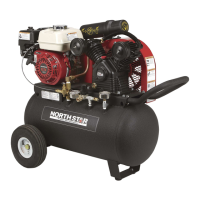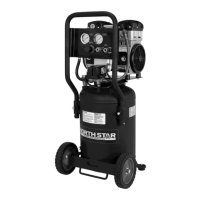M459232C.3
Owner’s Manual
Electric Stationary Air Compressor
(230V, single phase/80 gallon, 5 HP and 7.5 HP)
Instructions for Installation/Set-up, Operation, Maintenance, & Storage
This NorthStar® belt-driven compressor has a 2-stage 3-cylinder pump (Model 459232) or a 2-stage 2-cylinder pump
(Model 459242), made with a heavy-duty cast iron cylinders for long life, and a compact design rated for 175
maximum PSI. Its continuous-duty rating ensures long-lasting performance, and its cast iron pump head ensures
superior heat dissipation.
Read and understand this Owner’s Manual completely before using. Keep this manual for future review. Failure to
properly set up, operate and maintain the compressor in accordance with this manual could result in serious injury or
death to operator or bystanders.
WARNING: SPECIAL HAZARDS
Injection Injury: High-pressure air stream can pierce skin and underlying tissues, leading to serious injury and possible
amputation. Such an injection injury can result in blood poisoning and/or severe tissue damage.
Flying Debris: High-pressure air stream can cause flying debris and possible surface damage.
Not For Breathing Air: NorthStar compressors are NOT designed, intended, or approved for supplying breathing air. No
compressed air should be used for breathing unless air is treated in accordance with applicable standards.
Fire/Explosion: Sparks from air powered tool heads or attachments can ignite fuel or other flammable liquids or vapors in
the vicinity. Exceeding the maximum pressure for air tools or attachments could cause them to explode.
Burns: Compressor pump, motor and discharge tubing are hot surfaces that can cause burn injuries.
Electric Shock: Operating equipment in wet conditions or where not properly grounded can cause electric shock.
Detailed safety information about these hazards appears throughout this manual.
Equipment Protection Quick Facts
Inspect Upon Delivery: FIRST! Inspect for missing or damaged components. See “Initial Set-Up” section for where
to report missing or damaged parts.
Check Pump Oil: Pump is shipped with oil. Check the pump oil level before starting. See “Preparing for Operation”
section of this Owner’s Manual for capacity and viscosity.
Use Mechanical Lifting Equipment: Compressor is shipped on a pallet and is too heavy to handle manually. Use
proper lifting equipment for unloading and moving to installation site.
Install Using a Qualified Electrician: All wiring, grounding, and electrical connections must be made by a qualified
electrician. Install according to local and national codes.
Install a Regulator: We recommend installing a regulator on the compressor at each distribution point to maintain
constant pressure in the outlet hose line and provide reduced pressure appropriate for air tool being used.
Run Pump Unloaded for Break-in Period: Before initial use, open ball valve and run compressor for 30 minutes to
break in pump parts.
Follow Maintenance Schedule: Pump, air filter, and tank require periodic inspection and servicing to provide
efficient function and long life. See “Maintenance Schedule” for frequency of servicing.
ITEM NUMBER: 459232 & 459242
SERIAL NUMBER: _____________


